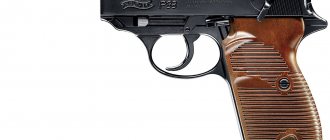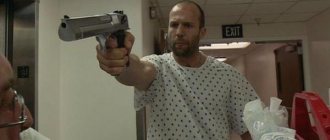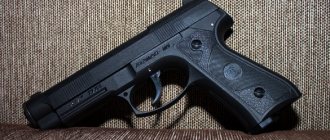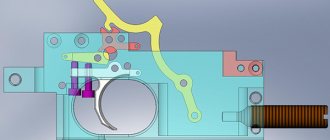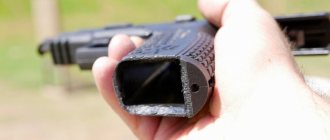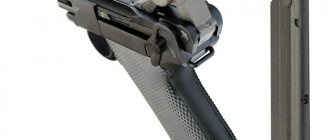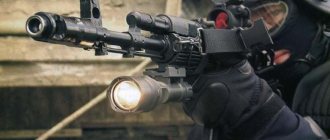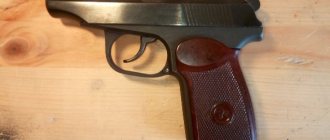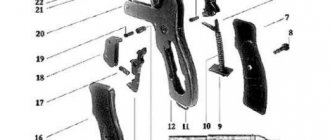Bullet shooting was already introduced at the first Olympics in five disciplines. Only men competed in shooting (women first took part in Olympic shooting competitions in 1968). In 1904 and 1928 There were no shooting competitions at the Olympic Games.
In bullet shooting, unlike skeet shooting, rifled weapons are used. Currently, most Olympic disciplines use air guns (pistol or rifle). In each discipline, a national federation may be represented by two athletes if they qualify for the Olympics.
Shooting competitions are divided into two types: bullet and skeet. Bullet shooting is carried out at stationary or moving targets from smooth-bore or rifled weapons. Can be fired from a pistol or rifle.
All participants in rifle shooting competitions must wear a special standardized uniform consisting of a jacket, trousers, gloves and shooting shoes.
When shooting a pistol, participants can compete in any clothing, but shooting shoes are a mandatory element of the uniform. When shooting at a moving target, the participant must wear a special shooting jacket.
When shooting from all types of weapons (except pneumatics), the participant must wear safety glasses and headphones.
Rifle shooting in three positions
Men. In this discipline, shooting is carried out from prone, kneeling and full-length positions - 40 shots from each position. The distance to the target is 50 meters. For shooting, a 5.6 mm caliber rifle is used, the maximum weight is 8 kg. Time to hit the center of the target: 45 minutes lying down, 75 minutes standing and 60 minutes kneeling.
Women. For women, the rifle is lighter - its maximum weight is 6.5 kg. Instead of 40 shots from each position, women fire 20. The time to hit the target in all three positions is 135 minutes.
Fire pistols
BAIKAL-442
BAIKAL-442
− self-loading pistol for sports and training shooting. The weapon was developed on the basis of the legendary 9mm Makarov PM pistol in the 1990s, when Izhmash’s military orders declined critically. BAIKAL-442 can be used both for shooting training and for sports activities. The pistol retains all the best qualities of its combat counterpart: ease of use and maintenance, safety and compact size. Like the PM, the sports modification has an automatic reloading mechanism by using the recoil energy of the free shutter. The pistol can be equipped with a laser sight.
MP-446C Viking-M
MP-446C Viking-M
− a sports modification of the Yarygin PYa pistol, the main short-barreled weapon of the Russian army. Developed and produced by the Izhevsk Mechanical Plant. This is a self-loading weapon of 9x19 mm caliber with a magazine capacity of 15 rounds. The pistol is modified in accordance with the rules of the Practical Shooting Federation and is intended for shooting training and practical shooting.
The Viking-M modification was first shown in 2016, and the first sports model appeared simultaneously with the adoption of the PV into service in 2003. In 2004, the MP-446С Viking became the first Russian pistol approved by the International Confederation of Practical Shooting as a weapon for practical shooting at international competitions in the “Serial Pistol” class.
The pistol of the Kalashnikov concern is simple and unpretentious in maintenance, easy to disassemble and affordable. The basic model was refined in collaboration with shooting athletes from the Russian national team. By changing the design of the barrel, it was possible to significantly increase the service life of the pistol - up to 50 thousand shots. The balance of the weapon has been significantly improved and the toss up when firing has been reduced, while a modified pistol grip and a convenient magazine release button have significantly improved the ergonomics of the weapon.
Lebedev pistol PL-15
Lebedev's SP1
pistol was first demonstrated in February last year. The basis was to take the Lebedev self-loading pistol, which was being prepared for mass production, developed at the Kalashnikov concern. Work on the pistol was carried out with the participation of Russian sportsman Andrei Kirisenko, a multiple national champion in practical shooting. The Lebedev pistol was developed for law enforcement agencies as an alternative to the Yarygin pistol.
The weapon retains all the advantages of the parent model: ergonomics, accuracy and accuracy of fire, and small thickness. In addition, it is possible to equip the pistol with laser designators, under-barrel flashlights and collimator sights. The sports SP1, like the combat PL-15, fires 9x19 mm cartridges. The pistol is made in two versions: made of aluminum alloy weighing 0.8 kg without a magazine and made of steel weighing 1.1 kg.
Pistol "Boa constrictor". Photo: TsNIITOCHMASH
Sports pistol "Aspid"
9x19mm has been developed since October last year by the TsNIITochmash team together with the Russian Practical Shooting Federation. Development is being carried out on the platform of the Udav pistol complex, which in September 2022 completed the stage of experimental military operation and was recommended for adoption.
The pistol's service life will be 25 thousand shots. The materials and components used in the gun will ensure its operation in the temperature range from minus 30 to plus 50 degrees. The new pistol is being developed in three versions for three classes of practical shooting: serial, lightweight, standard. The magazine capacity for a pistol of the serial and lightweight classes will be 18 rounds, and for the standard class - 22 rounds. The weight of the pistol without cartridges, depending on the configuration, will be from 800 to 1100 grams.
The lightweight Aspid will receive mounts for a collimator sight. The serial "Aspid" will be equipped with a Picatinny rail - a rail mounting system for sights and additional equipment. To improve ergonomics, the pistol handle will have seats for pads on the left, right and back sides, which will allow athletes to easily adapt the length and width of the handle to their anthropometric data.
Shooting at a running target
Shooting is carried out from an air rifle with an optical sight with a caliber of 4.5 mm and a weight of 5.5 kg. Only men compete in this discipline. The maximum magnification power of this scope is four. The distance to the target is 10 meters; when moving, the target is visible over an area two meters long. Shooting is carried out in two stages - slow and fast. At the slow stage of the competition, the target is within visibility for 5 seconds, at the fast stage - 2.5 seconds. The target moves first from left to right, then from right to left. In the preliminary round, 30 shots are allocated for each stage. In the final, participants fire ten shots.
Share link
Pneumatic guns
The Izhevsk Mechanical Plant, part of the Kalashnikov concern, produces sporting weapons under the Baikal brand. Since the 1960s, better civilian weapons from Izhmash were produced under this brand and were exported.
MP-657K
MP-657
– a line of budget pneumatics for those starting their path in sports. These pistols are transitional from recreational to sporting models. However, they fully satisfy the requirements of the rules of shooting competitions in the standard class. When developing them, the recommendations of leading trainers of the Russian Shooting Union were taken into account. The models in the line differ in the number of charges and the location of the gas cylinder.
MP-46M
MP-46M
(former IZH-46) is a compression-type sports pneumatic pistol. Produced since 1988. Its main difference is a manually cocked compressor located under the barrel. That is, gas cylinders are not needed for shooting; charging is done by the shooter himself. This popular model also meets the International Rifle Union's 10 meter fixed target regulations. The MP-46M has won the highest awards at the World and European Championships. The gun has ample opportunities for individual adjustments. In 2016, a smaller version was developed for beginner athletes.
MP-672
Model MP-672
created on the basis of the MP-46 using a pneumatic cylinder. The pre-inflated cylinder is located under the barrel. The pneumatic cylinder design provides greater convenience when shooting than the compression design, without reducing the accuracy characteristics.
Age groups of athletes
To participate in shooting competitions, gender and age groups of athletes are established.
| N | Group | Age |
| 1 | Boys and girls (junior group) | up to 17 years old |
| 2 | Boys and girls (senior group) | up to 19 years old |
| 3 | Juniors and Junior Women | up to 21 years old |
| 4 | Men and women | 14 years and older |
Boys and girls, juniors and juniors - athletes at least 10 years old are allowed.
Athletes of younger age groups have the right to compete in older age groups, but at the same competitions an athlete is prohibited from competing in different age groups.
Women, juniors and girls are not eligible to participate in men's, juniors and youth competitions.
Disadvantages of the sport
- Due to the high cost of the equipment necessary for training and the lack of government funding for sports schools, the cost of purchasing weapons falls on the students themselves (or their parents).
- Bullet shooting is less popular among young people and children. Team sports are more popular - hockey or football, as well as disciplines that involve working on the body.
- Shooting does not give quick results from training. This is a long-term sport, and few people agree to do it their whole life. The first victories can be won in 20-25 years, and this does not at all attract lovers of quick fame.
Benefits of classes:
- Strengthening the body
It is especially important for children and adolescents: the first stage of shooting training involves general physical training, which has a beneficial effect on health. The muscles of the arms, back, chest and legs are actively involved in the process of special training. This helps keep the body in good shape.
- Formation of emotional stability
Shooting helps develop great balance, concentration and self-control. Shooters learn to disengage from everything that happens around them and act calmly.
- Possibility of a long sports career
Children from 10 years of age are allowed to participate in classes. There is no upper age limit - you can practice shooting until you are old, including competing in competitions.
- Increasing gun responsibility
Future shooters are trained, among other things, in safety and proper handling of weapons. Classes develop the awareness that a rifle or pistol is not a toy and requires a serious attitude.
Nature of the competition
- Personal. In individual competitions, only personal results are determined.
- Team. In team competitions, teams meet each other, and based on the results of these meetings, the teams' places are determined. When holding team competitions in individual disciplines, except for disciplines with mixed teams, the composition of each team for all categories of athletes is three athletes. For such teams, places taken are determined, winners and runners-up are awarded, and records are registered.
- Personal-team. Results are determined by the achievements of each individual participant and the entire team as a whole.
- General team competitions with the determination of team places for sports teams based on the results of the participation of their athletes in the exercises of the program in the individual or team competition or individual and team competition at the same time.
- Complex competitions in types of shooting sports: bullet shooting, clay pigeon shooting, sporting, practical shooting and other types of shooting, which may be included in the program of competitions held in three or more sports.
Truth and fiction
Those who are not too aware of what bullet shooting is often have a very distorted idea about it, mostly associated with various stereotypes.
Here are the most important misconceptions:
- Shooting is dangerous.
Not at all. First of all, this is a sport, and in sports there are always strict rules, one of the main points of which is compliance with safety regulations. Instructions on it are carried out before the start of classes and are repeated more than once during the training process. Before participating in the tournament, shooters even sign a special report stating that they received safety instructions. And all responsibility for what happens in the future rests with them.
- Shooting is a way to have fun.
Athletes have a completely different opinion. For them, a weapon is an inventory that must be handled competently and carefully. Among those who practice professionally, there are no people who just come to shoot for fun. Much attention is paid to the study of technology and the development of certain psychological qualities.
- Bullet shooting is an unpopular discipline.
This is not entirely true. It is less popular than team sports because it is not as actively promoted. And yet, shooting has the status of an Olympic sport, and the national team has considerable achievements on this front. So, in 2016 at the Summer Olympics our shooters received 1 silver and 2 bronze. In addition to international competitions, competitions are held annually in many cities. There are also active shooting societies on a regional scale.
Conclusion
Bullet shooting develops concentration, discipline, and self-confidence.
The shooter knows how to handle a weapon and does not see it as a toy, but shooting as entertainment.
He understands that the result depends only on him, and there are no other team members who can help him.
If a parent wants to see their child balanced, with great willpower and a desire to win, then such a sport will probably be the best choice.
KROO "Federation of Bullet and Skeet Shooting of the Kaliningrad Region" Federation of Bullet and Practical Shooting of Kaliningrad
Source
